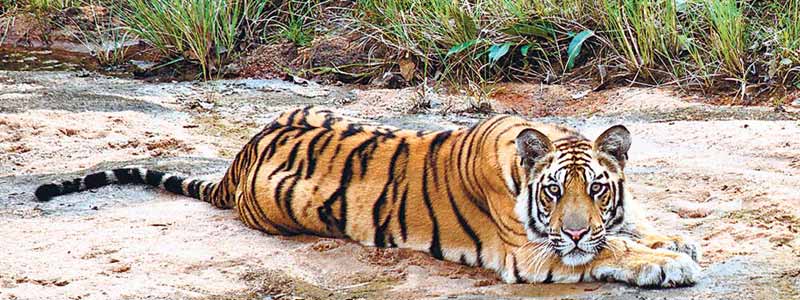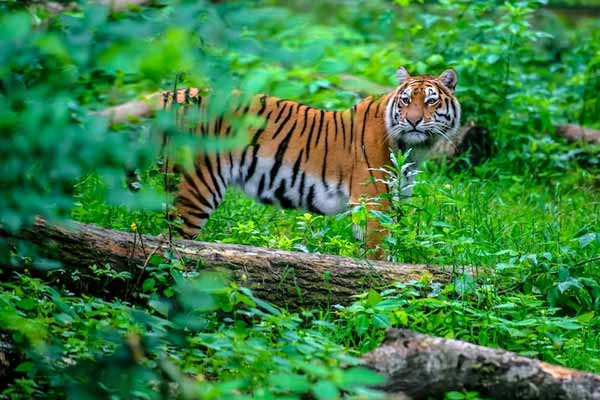Mukundra Hills Tiger Reserve is now the third tiger reserve of Rajasthan is also known as Darrah wildlife sanctury in the past is located in the southerneastern part of Kota town of Rajasthan. In the past it is the Royal Hunting Ground of the Maharaja of Kota. This place is located at a distance of about 50 km from Kota. It is located on the eastern bank of Chambal River and its tributaries toches this area.
The Darrah wildlife sanctuary was declared NATIOANL PARK Mukundra Hills Natioanl Park in 2004. Total area of the National park is about 200 sqkm. Mukundra Hills National Park is constiting of three wildlife sanctuaries namely Darrah wildlife sanctuary, Chambal wildlife sanctuary and Jaswant Sagar wildlife sanctuary. This park got the approval of Natioanl Tiger Conservation authority NTCA in 2013 and then the Rajasthan gets its third tiger reserve in the form of the Mukundra Hills Tiger Reserve, and now it is the home of four tigers which is recently shifted here from the Ranthambore Tiger Reserve.

History
The core area of Mukundra Hills National Park & Tiger Reserve is one of the oldest sanctuaries of India, popularly called as ‘Darrah Sanctuary’
Darrah was declared a Wildlife Sanctuary ( Protected Area ) in 1955.
Before Independence, it used to be the hunting protectorate of Kota state and was famous for its tigers, other big cats and deer.
It was declared as a National Park in 2004 and was given the name ‘Mukundra Hills ( Darrah ) National Park’ which was formed by combining three wildlife sanctuaries: Darrah Wildlife Sanctuary, Chambal Wildlife Sanctuary and Jawahar Sagar Wildlife Sanctuary.
In 2013, National Tiger Conservation Authority passed its approval and Rajasthan got its third Tiger Reserve after Ranthambore and Sariska. While being declared as a Mukundra Hills Tiger Reserve failed to get a single tiger for many years.

Other Attractions at Mukundra Hills
The rich biodiversity of Mukundra Hills Tiger Reserve Kota with the enthralling view of Chambal makes it different from the other Tiger Reserves of its kind.
- Migratory Birds
Mukundra Hills Kota hosts a variety of migratory birds in winter including gray pelicans, Bar Headed Goose, Ruddy Shelduck, Gray Lag Goose along with the Pied cuckoo, Jacobin cuckoo, Eurasian cuckoo and many more.
If you are into bird watching, then this place is a true heaven for you!
- Waterfalls
Waterfalls greet their visitors with bundles of joy and serenity along with thrill and amazement.
The beauty of a waterfall is impossible to convey in a mere combination of words.
Some of the breathtaking Waterfalls which you can find here are: Geparnath Waterfall, Padajhar Waterfall and Garadia Waterfall.
- Water Safari
This is one of the most exciting features of Mukundra Hills Tiger Reserve is perhaps the first tiger Reserves to host both water Safari and Jungle Safari in its stretches.
Aren’t you excited to be dabbed by some cool splashes of Chambal on your visit to Mukundra Hills Tiger Reserve ? wink wink
- Flora and Fauna
The Mukundra Hills Kota has gently sloping hills covered with ‘Dhok’ trees and a mixed jungle of sheesam, belimali, arjun, ficus, khair, gurjan and salar. Sambhar, cheetal, chinkara, Neelgai and four-horned antelope are the true deer, gazelle and antelope found in the reserve. Leopard are common and so are the wolf, jackal, hyena and sloth bear.
Paradise flycatcher, Golden oriole, a variety of woodpeckers, flycatchers, doves, babblers, mynas, sandgrouse, nightjars, eagles, owls and vultures form the most important and conservation dependent avian species of Mukundra Hills Tiger Reserve.
The lakes and ponds within the Reserve support a wide variety of migratory and resident waterbirds, including geese and ducks.
- Breathtaking Views
With the azure streams of water, the region is a blessing not only for the wildlife photographers but also for those who love capturing the adorable and mesmerizing sites of nature.
Visit Mukundra Hills Tiger Reserve to lens some of the finest and most picturesque landscapes found in nature.
Best time to visit
Tourists can visit the sanctuary from October till July, but the ideal time to visit Mukundra Hills Tiger Reserve is between February to May. The sanctuary is open throughout the year except between 1st July to 30th September.
Timings are from 10 am till 5 pm everyday. However, for visiting the sanctuary, tourists have to take a signed permission from the local forest ranger.
How to reach?
By air – The nearest airport from Mukundra Hills Tiger Reserve/Darrah National Park is Udaipur, which is around 300 km from Kota.
By Rail – The closest railway station is Kota railway station located about 50 km from Mukundra Hills Tiger Reserve/Darrah National Park.
By road – The distance between Mukundra Hills Tiger Reserve and Kota is close to 50 km only. It is also well connected all the major cities of Rajasthan like Ajmer, Chittorgarh, Jaipur, Udaipur, etc.
